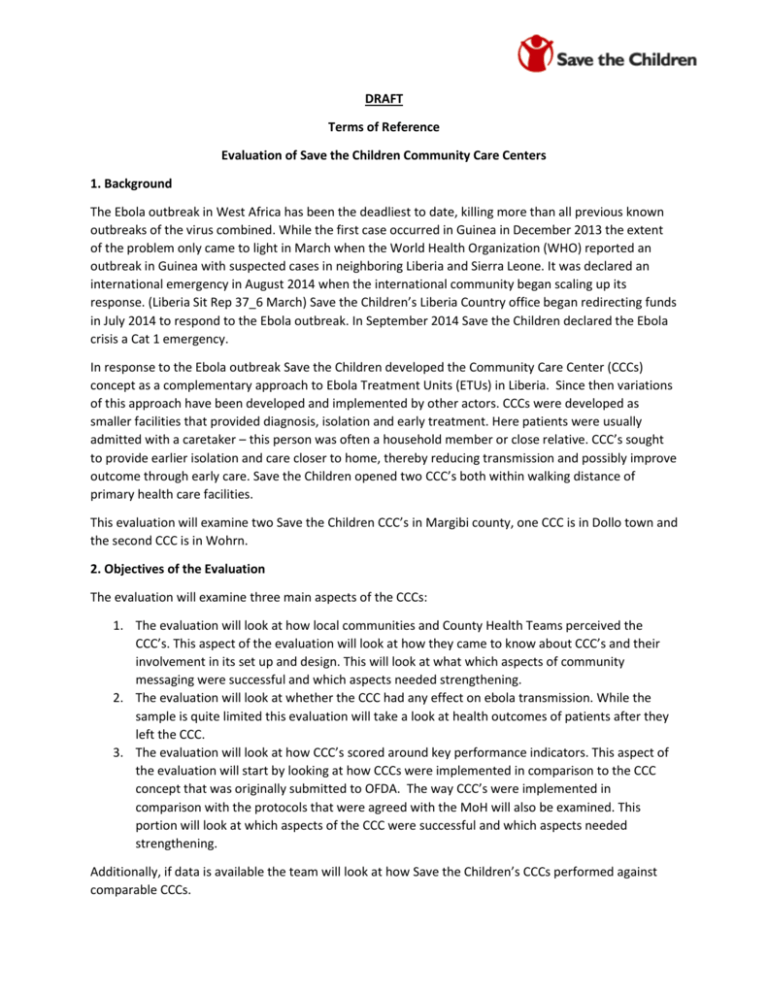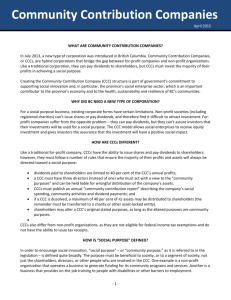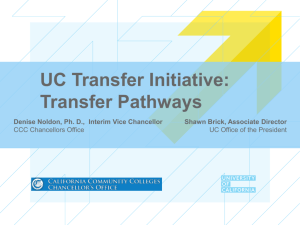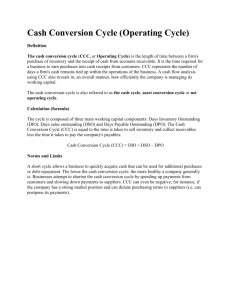Terms of Reference
advertisement

DRAFT Terms of Reference Evaluation of Save the Children Community Care Centers 1. Background The Ebola outbreak in West Africa has been the deadliest to date, killing more than all previous known outbreaks of the virus combined. While the first case occurred in Guinea in December 2013 the extent of the problem only came to light in March when the World Health Organization (WHO) reported an outbreak in Guinea with suspected cases in neighboring Liberia and Sierra Leone. It was declared an international emergency in August 2014 when the international community began scaling up its response. (Liberia Sit Rep 37_6 March) Save the Children’s Liberia Country office began redirecting funds in July 2014 to respond to the Ebola outbreak. In September 2014 Save the Children declared the Ebola crisis a Cat 1 emergency. In response to the Ebola outbreak Save the Children developed the Community Care Center (CCCs) concept as a complementary approach to Ebola Treatment Units (ETUs) in Liberia. Since then variations of this approach have been developed and implemented by other actors. CCCs were developed as smaller facilities that provided diagnosis, isolation and early treatment. Here patients were usually admitted with a caretaker – this person was often a household member or close relative. CCC’s sought to provide earlier isolation and care closer to home, thereby reducing transmission and possibly improve outcome through early care. Save the Children opened two CCC’s both within walking distance of primary health care facilities. This evaluation will examine two Save the Children CCC’s in Margibi county, one CCC is in Dollo town and the second CCC is in Wohrn. 2. Objectives of the Evaluation The evaluation will examine three main aspects of the CCCs: 1. The evaluation will look at how local communities and County Health Teams perceived the CCC’s. This aspect of the evaluation will look at how they came to know about CCC’s and their involvement in its set up and design. This will look at what which aspects of community messaging were successful and which aspects needed strengthening. 2. The evaluation will look at whether the CCC had any effect on ebola transmission. While the sample is quite limited this evaluation will take a look at health outcomes of patients after they left the CCC. 3. The evaluation will look at how CCC’s scored around key performance indicators. This aspect of the evaluation will start by looking at how CCCs were implemented in comparison to the CCC concept that was originally submitted to OFDA. The way CCC’s were implemented in comparison with the protocols that were agreed with the MoH will also be examined. This portion will look at which aspects of the CCC were successful and which aspects needed strengthening. Additionally, if data is available the team will look at how Save the Children’s CCCs performed against comparable CCCs. 3. Key Questions 1. How do local communities and County Health Teams perceive the effectiveness and usefulness of CCCs? a. Where did they get information on the CCCs? b. What are the barriers of seeking care at the CCC? c. What methods of community engagement worked and how did this affect attendance? d. What do the communities think should happen to the CCCs in the future? e. Did communities and county health teams influence/participate in the design/location, construction and utilization of the CCCs? f. Where did patients at our CCC come from? Do they have any common sociodemographic characteristics g. How did the community aspect of the CCCs come into our management? How did we do? 2. Were there any likely cases of transmission of ebola at the CCC to patients that had initially tested negative, to health workers, or to caregivers? 3. How did the Implementation of the CCCs compare to the CCC concept that was submitted to OFDA? If there were changes how did they come about and what was the effect of those changes? a. What services were provided at the CCCs? For example, nutrition, pediatric, obstetric care? Was psychosocial support provided to patients/caregiver/staff? b. Did the CCC’s help to decongest the PHC and ETU? 4. How do CCCs perform against the protocols agreed with the MOH? Questions include: a. How was patient flow managed during triage, isolation and care of suspected/confirmed patients? b. How was IPC managed during triage, isolation and care of suspected/confirmed patients c. Were adjustments to the protocols required? Were additional protocols sufficient d. What was the overall safety and security of CCCs? 5. How did CCCs perform against a set of performance indicators including: a. Mortality b. Average time from onset to admission c. Average time for patient transfer when ETU bed available d. % of patients who were transferred to ETU e. Average time after admission for laboratory result f. Proportion of patients that met the case definition for EVD g. Average time for collection and disposal of EVD waste h. Average time for collection and disposal of bodies i. Presence of PPE stock for 2 weeks and availability of other supplies 6. .Staffing of CCCs a. What level of training, including on-site training, did health care workers receive to work in the CCCs? b. What level of training did hygienists receive to work in the CCCs? c. What were the risks CCC staff felt they were exposed to while working in the CCC? d. What were staff perceptions on their contributions to working on the Ebola outbreak? 4. Evaluation Methodology The evaluation will make use of qualitative and quantitative methods. Primary data collection will be through consulting beneficiaries, community members, county health teams, CCC staff and other relevant Save the Children staff through Focus Group Discussions, Key Informant Interviews as well as the use of participatory workshops and other methods. Follow-up surveys of clients of the CCC’s will be conducted. These surveys will examine how patients came to know of the CCCs and will examine their perceptions of the CCC. The Survey will try to see if there were any key characteristics that made CCC messaging successful for them. Additionally the surveys will also gather data on health outcomes of patients and their caregivers. Enumerators from Margibi and Bong will be hired and trained to conduct these surveys on electronic tablets to speed up data collection. The quantitative component of the evaluation will review and analyze data from the patient surveys, from existing program documentation, and the CCC database. Observation of care in the CCCs will also be used to examine the facilities, procedures, arrangements, etc. Photographs will be taken to illustrate this. 5. Evaluation Team The evaluation team will be a small team with multidisciplinary backgrounds in monitoring and evaluation, health, anthropology, and community engagement. The team will mobilize and train enumerators and local assistants who will facilitate direct engagement with communities. Key Skills and Qualifications represented on the team - Previous experience leading an evaluation - Previous experience leading a survey and training enumerators - Understanding of the context and social and psychological responses to the Ebola outbreak - Experience with epidemiological analysis - Skilled in community engagement - Experience in managing and designing emergency health programs - Knowledge of Liberia - Comfort working with Excel, Access, & electronic tablets 6. Activities and Timeframe Data collection in Liberia will begin by April 27th Debriefing meeting with Save the Children and other key stakeholders will be held in Liberia on completion of fieldwork to discuss preliminary key findings. It is anticipated that the field mission will be a maximum of 15 days including the feedback meeting. 14 days for writing the first draft and an additional 4 days to incorporate feedback. 7. Coordination The Consultants will arrange their own visas, insurance and flights to Monrovia. Save the Children will arrange for transportation and lodging once in country. Save the Children will also support the recruitment of enumerators and will provide the electronic tablets for data collection. Save the Children will identify a person from Save the Children who will be the main point of contact with the evaluation team and will ensure that the team receives a security briefing, support the identification of Save the Children key informants, provide key documentation from the CCCs, coordinate feedback to the draft report, and discuss any issues that emerge during the evaluation with the team in a constructive and amicable fashion to reach agreement on solutions. 7. Expected Outputs The following completed documents are the expected outputs of the evaluation: Final methodology and tools Draft report Final report no more than 25 pages excluding annexes Executive summary no more than 5 pages Debrief with relevant program staff and Senior Management Team





